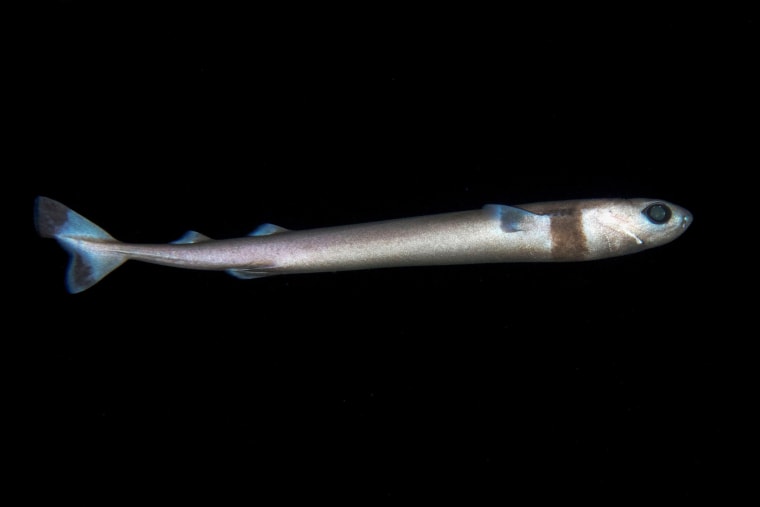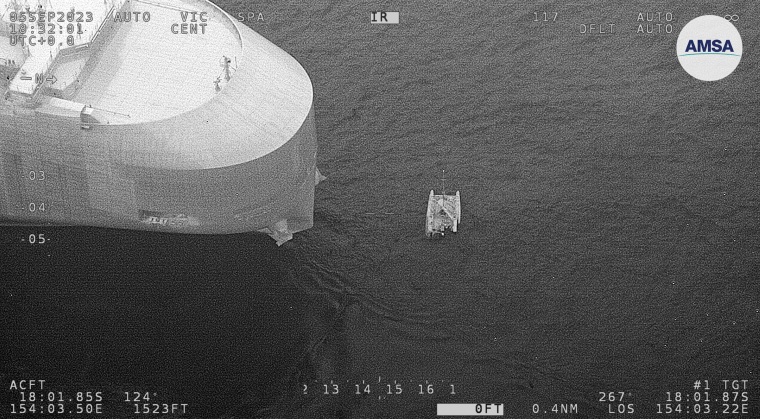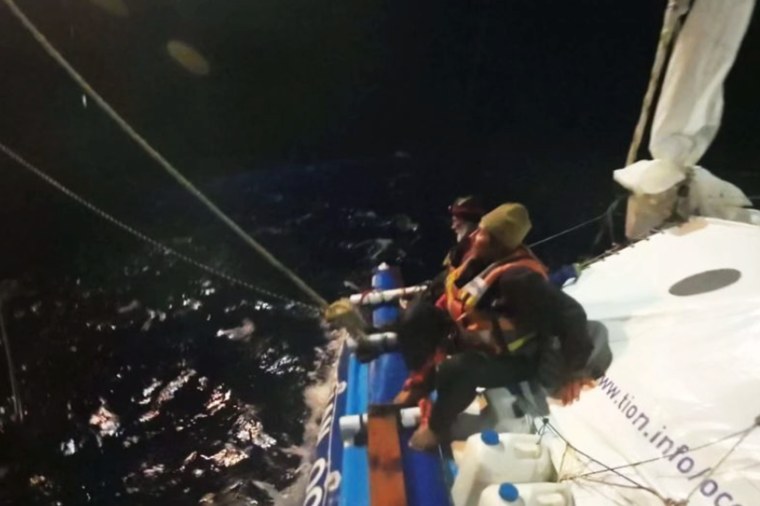3 men rescued after sharks repeatedly attacked their inflatable boat off Australia
Three sailors were rescued from a sinking inflatable catamaran Wednesday after it came under repeated attack by sharks that stranded them more than 500 miles off Australia .
Rescuers picked up the men, two Russians and a Frenchman, after their emergency beacon sent out a distress call at 1:30 a.m. eastern Australian time (11 a.m. Tuesday ET), the Australian Maritime Safety Authority, or AMSA, said in a statement .
The crew had embarked from the Pacific island nation of Vanuatu on Aug. 28 and were headed to the Australian city of Cairns on the latest stage of an around-the-world trip.
But several shark attacks damaged both hulls of their 30-foot boat.

The catamaran had “large sections of its hull missing,” Joe Zeller, a senior manager at AMSA, said in a video statement.
"An emergency beacon absolutely saved their lives," said Zeller, who was on call when the distress signal was received.
A huge Panama-registered vehicle carrier, the 650-foot Dugong Ace, carried out the rescue in the Coral Sea. The unharmed sailors, ages 28 to 64, are expected to arrive in Brisbane on Thursday.
AMSA did not name the rescued men. The expedition is led by Evgeny Kovalevsky, alongside crew member Stanislav Berezkin, both from Siberia.
The project's website lists Vincent Thomas Etienne as an extra crew member participating in the Tahiti-Australia stage. The boat is a Russian-registered catamaran named “Russian Ocean Way — Tion.”

A spokesperson for the expedition said by text message that Yulia Kalyuzhnaya, the head of the operation, will fly to Australia to meet the sailors and discuss the future of the voyage.
“Now [the] travelers are safe, this is the most important thing. Unfortunately, the catamaran could not be saved. The fate of the expedition will be clear next week,” the spokesperson said.
The trip from Vanuatu to the trio's intended destination of Cairns, Australia, is more than 1,200 miles. AMSA said it would normally take two to three weeks depending on weather conditions.
An Instagram account for the voyage said the boat was first attacked Monday by cookiecutter sharks, a small species that grows to around 16 inches and is linked to only a handful of attacks on humans. That caused the boat to partly submerge, but it limped on for 100 more miles.

It was attacked again Tuesday, when sharks pierced its right-side hull, causing it to start sinking.
Satellite photos and a video on the AMSA website showed the extent of the damage, with the boat clearly listing and losing buoyancy.
The crew and their belongings were saved, but the catamaran was lost.
“There are many reasons vessels are attacked by sharks, but the motivations of these sharks is unclear,” Zeller said in a video statement released by AMSA. The trio were “very happy” to be rescued, he said.

The boat set off from St. Petersburg in July 2021, led by Kovalevsky and Berezkin.
The pair said they were emulating pioneering Russian explorers of the 19th century. The voyage was planned to coincide with the 250th anniversary of the birth of Adam Johann von Krusenstern, who led the first Russian round-the-world voyage.
The plan was to visit 40 countries and return to St. Petersburg in July 2024, but the future of the project is now in doubt. Russia’s Ministry of Science and Ministry of Education, as well as the state broadcasting company, are listed as "information partners" on the project's website.
AMSA has used the incident to remind sailors to always carry the appropriate safety equipment. "This is a timely reminder to always carry a distress beacon while on the water. GPS-equipped EPIRBs and personal locater beacons (PLBs) can save your life in an emergency," it said in a statement. (EPIRBs are emergency position-indicating radio beacons.)
Patrick Smith is a London-based editor and reporter for NBC News Digital.

How a 40cm cookiecutter shark deflated a 9-metre catamaran off the coast of Cairns
By Jameela Timmins
Topic: Shark Attacks
A cookiecutter shark (Isistius brasiliensis). ( Flickr: NOAA Photo Library )
How can a 40-centimetre shark deflate a 9-metre catamaran?
On Wednesday at 1:30am three sailors attempting a round-the-world voyage activated their emergency beacon after their boat was attacked by sharks 800 kilometres off the coast of Cairns, and began to sink.
The craft left St Petersburg on July 1, 2021, in a bid to break the world record for cruising distance in an inflatable sailing trimaran.
The crew — Russians Evgeny Kovalevsky and Stanislav Beryozkin, and Vincent Thomas Garate from France — were rescued by a cargo ship and arrived at Mooloolaba Harbour, on the Sunshine Coast, today.
Russian sailors Stanislav Beryozkin and Evgeny Kovalevsky have been rescued from a sinking catamaran in the Coral Sea. ( Supplied: Russian Geographical Society )
It's suspected their craft was set upon by cookiecutter sharks.
It's the second catamaran to be used in the attempt, after the first vessel — Russian Ocean Way — was punctured by sharks in Tahiti in June.
The trio had also made an earlier attempt in March on a trimaran but the trip was abandoned for other reasons.
What are cookiecutter sharks?
Cookiecutter sharks are little, but their prey is not.
"Cookiecutter sharks are unique in that they're very small, usually around 40 centimetres," Daryl McPhee, an associate professor of environmental science at Bond University, said.
"They generally feed on large prey including whales and large fish."
The teeth of a cookiecutter shark, which feeds on big fish. ( Supplied: Robert Zelugaro )
The sharks have an "odd and somewhat frightening array of teeth they use to grab their prey and twist to bite a circular piece off," he said.
They can do this to an animal several times, slowly eating their prey.

Are they a threat to humans?
It is very rare for a cookiecutter shark to attack a human, and of the small number of attacks recorded, none were fatal, Dr McPhee said.
The first reported cookiecutter shark attack was in Hawaii in 2011, when the victim was swimming in deep water late at night.
The most recent attack was on a 7-year-old boy on Magnetic Island in 2017.
Why did the boat fall prey?
Cookiecutters are opportunistic feeders – they aren't fussy, Dr McPhee said.
Unlike most other breeds of shark who feed at dusk and dawn, cookiecutter sharks are night-time feeders and prefer tropical waters.
It's not unheard of for them to attack inanimate objects, with reports of attacks on submarines and underwater cables, Dr McPhee said.
Bond University's Daryl McPhee says the catamaran was likely mistaken for a whale carcas. ( Supplied )
It is likely that the sharks mistook the inflatable catamaran for a whale or dolphin carcass, causing punctures to two out of its three hulls, he said.
The small sharks can make "short work of inflatable boats", Dr McPhee said.
Should we be worried?
Dr McPhee said this attack was likely an isolated one.
"I don't suspect we're going to see a global spate of cookiecutter shark bites anytime soon," he said.
